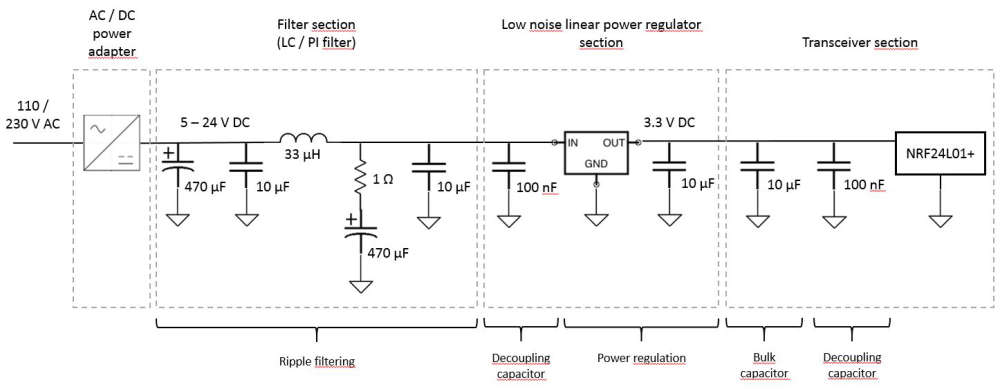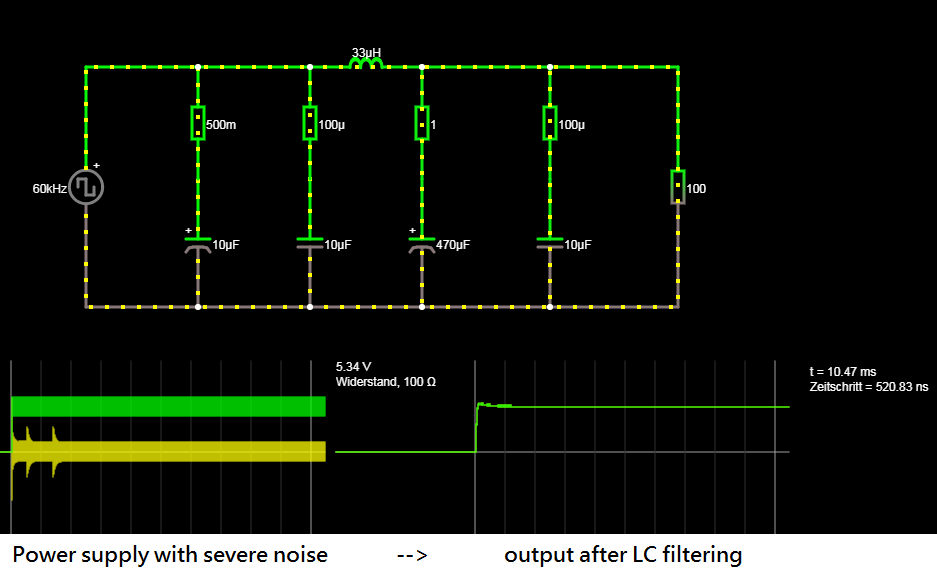Hi guys,
I'm writing this not because I have a problem but because I was finally able to solve some. I think it's worthwhile posting my experience here to maybe help some of you.
For a long time I was experiencing random unreliable radio communications with NRF24L01+ nodes powered by power adaptors. Some of my nodes worked perfectly while some others were receiving data really inreliably and generally had problems communicating. After a lot of try and error and reading some tips I think I have now found a reliable solution: Power supply input filtering.
I knew for a long time that the transceivers we use are highly sensitive to the cleanliness of their power supply and that typical cheap AC / DC switching power supplies (like e.g. a 5V phone charger) produces pretty noisy DC. But due to lack of an oscilloscope I didn't really know what to do about that.
After I've read this awesome post I tried putting such a recommended LC filter between the output of my LDO and the transceiver to clean out the power supplied to the transceiver. Unfortunately it didn't really work and I still had the same problems. After a lot of trying and playing around I have developed the theory that some linear power regulators are very pedantic about their output capacitors (specifically their respective ESR values) and you have to be really careful about what to put on the output of those things. I also learned that LC filter design is not as trivial as I thought: In bad case scenarios such a filter can start to oscillate and make things worse. So if you don't really know what you're doing and don't have an oscilloscope it is difficult to accurately design a working filter.
So my proposed solution is the following: Put such an LC filter directly between the output of your AC/DC power brick and the input of the power regulator. Linear LDO regulators typically already output pretty clean DC voltage, but only if their input is also kinda clean. The parameter that describes this correlation is called the "PSRR" or "power supply ripple rejection". In other words: shit in --> little less shit out.
By putting an LC filter (or Pi filter, whaterver) in front of the power regulator you are pre-filtering most of the bad output ripple of the cheap AliExpress 5V phone chargers and other power bricks. This "kinda clean" voltage is then supplied to the LDO which can do the rest of the work and filter out the remaining ripple or oscillation.
I don't know if my description is absolutely accurate and if it is the best solution that also a professional electronics design engineer would choose but at least for me it was the first thing that really worked.
In the end my proposed "optimal" (in respect to complexity vs. benefit) power chain can look like this:

I don't know if the capacitor and inductor sizes are optimal, but something approximately to this is running flawlessly in my home on several nodes. As an LDO I have been successful with the MIC5205 (same as Arduino Pro Mini), AMS1117, MCP1700, LE33 and LP2950 (this was the one I initially had the most problems with).
Also if you want to use such a design, keep the components of the individual sections as close as possible together. Between the blocks you can (within reason) do what you want, but you will get the highest quality out of short distances within the sections.
edit: I played around with different filter values in circuitjs and updated some things in the proposed circuit diagram. I decreased the inductor size from 333uF to 33uF (Low-pass cutoff frequency is higher but should be sufficient for AC adapters with a switching frequency higher than ~60kHz) and roughly doubled the size of the LC filter capacitor. Also I implemented a damping resistor (1 ohm resistor in series with 470uF capacitor) to optimize the behavior. Here you can see the result:

